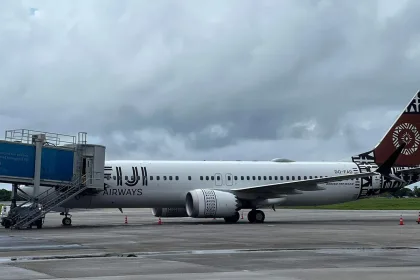The last century has seen the aviation industry grow exponentially. Danny Sitnam, President and CEO of Helijet International, explains how investing in new technologies amidst a climate of modernization has kept the company at the top of its game.
ENABLING EVOLUTION
Year on year, North America’s aviation industry sees constant change to its regulations, economies, and environments, whilst the travel habits of the public cannot be predicted.
Nevertheless, Helijet International (Helijet) revels in the challenges and opportunities that an active and exciting sector presents, and anticipates positive change as new developments emerge.
““In a nutshell, aviation is an exciting yet challenging sector. As aviators, we enjoy change and get very complacent being stagnant,” opens Danny Sitnam, President and CEO of Helijet.
As a solutions company for air transportation based in British Columbia (BC), Helijet is well known as North America’s largest and longest standing scheduled helicopter air service. Operating across the Pacific Northwest of the US, it offers a wide range of scheduled, scenic, and corporate charter flights.
Lesser known is the company’s engagement in air medical operations. Having operated its Sikorsky S-76 helicopter as a dedicated medical vehicle for over 25 years, Helijet offers considerable high acuity aid.
“We are BC’s largest dedicated air medical service provider,” Sitnam reveals.
As a result of its work with the British Columbia Air Ambulance Service (BCAS), Helijet has subsequently been tasked with overseeing 52 air ambulance heliports and landing zones across the nation. Therefore, the management and operation of heliports has evolved as a sizable subdivision of the company.
“By default, we’ve become an infrastructure organization. We consult international companies in developing heliports and vertiports, which is now a big part of our business,” he comments.
With a wide and varied range of products and services at its fingertips, a reputation for excellence, and having played a key role in the development of BC’s aviation industry over the past three decades, the Helijet name garners respect and recognition from across the globe.

ADVANCED AIR MOBILITY
In recent years, the evolution of advanced air mobility (AAM) has taken the aviation and aerospace industries by storm.
By creating innovative, quieter, and more cost-effective automated aircraft, with a significantly lower carbon footprint due to being powered by electricity or hydrogen, AAM poses major improvements to aviation as we know it.
“It’s exciting to see the direction AAM is moving in, as it will change the dynamics of how the industry will operate in the future,” Sitnam enthuses.
In 2019, Helijet became a founding member of Canadian Advanced Air Mobility (CAAM), and last year announced its plans to become the first Canadian air carrier to provide services using electric vertical takeoff and landing (eVTOL) aircraft – an adopter of AAM.
“Back in October, we made the significant announcement to provide passenger and cargo services using eVTOLs. We put firm orders in with BETA Technologies (BETA) for its ALIA 250 eVTOL model, which is estimated to be commercially certified in 2027.”
Notably, eVTOL poses significant enhancements to Helijet’s emergency response capabilities, especially when serving remote areas.
As a leader in electric aerospace engineering and AAM, BETA emerges as a beneficial partner for Helijet.
“We’re excited to work with BETA, and it was important for us to put in a firm order with them, so regulators like Transport Canada can see how serious we are about AAM. We can’t do it by ourselves – we need a whole community of stakeholders to bring this to life,” Sitnam emphasizes.
Helijet’s decision to partner with BETA is also due, in part, to the latter’s intention to certify the ALIA eVTOL for instrument flight rules (IFR) operations.
“BETA was the only company we could identify that was serious about certifying AAM vehicles for IFR when we did the assessments on original equipment manufacturers (OEMs),” he explains.
Committed to introducing zero-emission vertical lift technologies to the communities it serves, Helijet looks forward to utilizing AAM to transform the aviation landscape in BC in coming years.

STEWARDS OF SOCIETY
As an environmentally conscious province, BC is committed to reducing its greenhouse gas (GHG) emissions to 80 percent below 2007 levels by 2050. Helijet plays its part in achieving this goal by actioning a range of sustainable practices.
“As a company, a lot of our carbon footprint is offset. We manage this monthly, by reporting to and paying into the recognized Coastal First Nations carbon offset program,” Sitnam details.
Further to this, Helijet is in the process of converting its ground shuttle vans to electric vehicles (EVs) and installing electric charging stations within all its heliports.
“This means all our customers and employees can use EVs to travel to and from our facilities. We’re transitioning by funding around CAD$1.5 million into these,” he comments.
Helijet is also designing future plans to implement new infrastructure at its Vancouver International Airport for all its air operations, using sustainable, organic building materials.


In addition to Helijet’s focus on sustainability for the betterment of society, Sitnam himself has recently embarked on a charitable mission in co-founding Helicopters Without Borders.
“Helicopters Without Borders is a non-profit, Canadian and US registered charitable organization. My son and I started it because we want to use technology and aviation, especially new sustainable technologies, to help communities and people who don’t have access to aviation,” he divulges.
Helicopters Without Borders delivers goods and services to rural and Indigenous communities across BC, some of which are located up to 10 miles away from a town or city.
“We deliver to these communities via helicopter or plane at no cost to the end user, because we fundraise all the capital required to operate the aircraft and make that delivery air service,” he continues.
Having grown in recognition over recent months, the program has expanded to include the delivery of mobile dental clinics, dentists, and other clinicians to the most remote and rudimentary areas within the BC province.
“A lot of it is about respecting the community and its elders, who may be apprehensive to come into the city; we therefore bring that caring relationship to the community’s peoples so they’re a little more comfortable.”
Due to the opportunity to one day utilize new, sustainable aircraft, Helicopters Without Borders will be able to deliver goods and services in an environmentally-friendly way.
“Helicopters Without Borders is a strong and well-respected initiative,” Sitnam states confidently.
PARTNERSHIPS AND FUTUREPROOFING
To Helijet, healthy cross-company relationships and partnerships are invaluable given the fast-paced and changeable nature of the aviation industry.

I’m a big believer that partnerships are important, especially in this expanded AAM environment we’re stepping into.
Danny Sitnam, President and CEO, Helijet International
Notably, Helijet’s relationship with BETA is its most recent and significant.
“The relationship with BETA is important because we needed a company that not only builds aircraft, but has also developed charging infrastructure. We can’t fly these aircraft without a charging station,” he explains.
The company hopes that, in the future, BETA’s advanced charging infrastructure can be implemented within its existing heliports and future vertiports.
Another long-standing partnership that is important to Helijet is the company’s relationship with Blade Urban Mobility (Blade), a New York-based, technology-powered global air mobility platform.
Having established an operating partnership with Blade in 2021, including exclusive rights of sale of seats, Helijet hopes to position itself and Blade as leaders in the industry, especially as the dawn of AAM and eVTOL grows ever closer.
“Blade’s priorities align with ours insofar as wanting to bring the AAM community forward and introduce sustainable technologies to the aviation industry. We’ve joined forces to become corporate partners in developing our markets together.”
As 2024 unfolds, Helijet wishes to continue to engage with innovative and forward-thinking partners such as BETA and Blade.
“We want to work with new and emerging AAM players,” Sitnam states.
In a post-COVID-19 climate, the company strives to maintain and nurture its existing partnerships, ensure that travelers continue to choose Helijet, and reinforce its strong position within the market.
“We’re focused on rebuilding our market position, as the pandemic took a big swipe at that. For 2024, it’s a question of economic sustainability,” he concludes.























